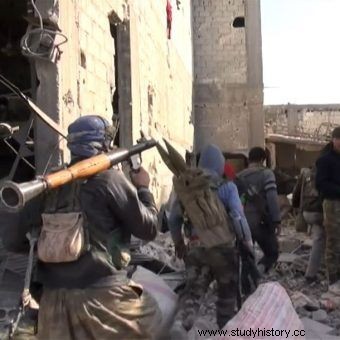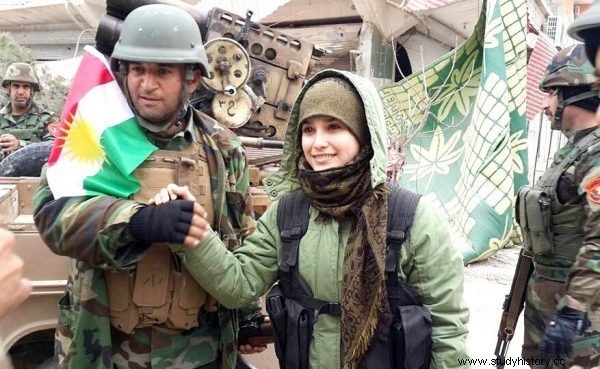The murderous confrontation changed the fate of the greatest war of this century. In the West, it is sometimes compared to the uprising of Warsaw in 1944. Is it right?
In mid-September 2014, the Islamic State besieged Kobane, a region and city in Rojava in Western Kurdistan, right on the Turkish border. The growing strength of ISIS, followed by a victorious march so far, attacked the province and the city of nearly 45,000 inhabitants. The Islamists expected them to take Kobane without too much trouble. They threw large forces into the fight, attacking with tanks, rocket launchers and artillery.

YPG in Kobane (photo:public domain)
Taking over successive villages and towns, they forced the members of the Kurdish Universal Protection Units (YPG) fighting in this area to constantly withdraw. A wave of civilian refugees moved towards the Turkish border. The Kurds, knowing that if they were captured by militants, their death might await, they wanted to find shelter in a neighboring country. However, a significant proportion of the refugees from the region were refused help and were returned to Kobane.
Like a noose around a hangman's neck?
The Islamic State closed the ring around the city, and the YPG forces controlled only a dozen nearby villages, one smaller city and Kobane itself. Kurds, constituting a significant ethnic minority in Turkey and demanding their own state, are a salt in the eye of the local authorities. Ankara not only did not intend to help Kobane's defenders, but also made it difficult for others to provide such support. Ultimately, however, despite Turkish harassment, an international coalition led by the Americans began bombarding ISIS positions from the air, including a village four kilometers outside the city, where militants set up an operations center.
However, this did not stop the tightening of the siege ring. Civilians fleeing the Islamic State talked about the unimaginable horrors that took place almost in the suburbs of Kobane, about rapes, robberies, torture, or public executions of Kurdish soldiers (beheading). At the beginning of October it was already known that the defenders would face an unequal battle for the city.
The fights were very hard. Both sides alternately conquered the blocks of streets and were rejected from them. Suicide bombers also joined the clashes on both sides. In the following weeks, the US continued air strikes against militants. Kurds also received supplies from the air. ISIS intercepted one of these packages, which included, among other things, grenades, ammunition and grenade launchers (as proof, the militants posted the video on the Internet). After all, the initiative was still on the side of the Islamic State, which repeatedly repeated brutal attacks. In the last days of October the card started to flip and support broke into town.

Coalition attack on ISIS positions around Kobane (photo:public domain)
The defenders were joined by soldiers of the Free Syrian Army, a large unit of Iraqi Peshmerga (experienced Kurdish partisans, fighting for Kurdistan independence and guerrillas) with heavy weapons, and several trucks with weapons and ammunition from Iraqi Kurdistan. In early November, Kobane defenders began seizing the initiative, and the morale of the militants was tarnished. The next parts of the city fell back into the hands of the Kurds. Jihadists resorted to the use of shahid-striped trap and suicide cars, but gradually lost building after building and street after street. On January 26, 2015, Kurdish forces managed to recapture the entire city, and then began to drive ISIS out of other territories around it.
City-symbol
The defense of Kobane has become a symbol of resistance against the Islamic State's offensive in Iraq and Syria, which is the cause of the humanitarian catastrophe plaguing the region. After the jihadists were driven out of the city, their winning streak so far has collapsed. They were forced to go on the defensive.
An interesting analogy between the events in Rojava in the Middle East and in Warsaw is published by Neville Teller in his book "The Chaos in the Middle East:2014-2016". He sees disturbing similarities between Kobane and Warsaw, and between the attitudes of Turkey and Stalin. He writes about the dramatic struggle, the tragedy of civilians and the razing of the city to the ground. He also emphasizes that in 1944 Stalin deliberately halted his army's offensive to see the Polish uprising crushed. In his opinion, the behavior of the Turks in 2014 was alarmingly similar.
Islamic State was in retreat after the battle for the city, but this did not mean that the fighters gave up. In July 2015, a British volunteer Ed Nash appeared in this area, who together with a dozen foreigners came to support the Kurds in the fight. The image that appeared before his eyes was simply terrifying. As he noted in his memoirs, just published in Poland under the title "Desert sniper" most of the city was in ruins. Only sad skeletons remained of the numerous buildings. In total, seventy percent of the buildings were destroyed. As stated by Ed Nash :
A few weeks ago, while we were still in the mountains, there were a series of suicide attacks on various objects in the city. They resulted in the deaths of several hundred people, including about a hundred children at school. It had lasted two days then, and now everyone understood that it could happen again. Nevertheless, what we saw with our own eyes far exceeded our expectations.
The British, however, was most surprised by the people he encountered among the piles of rubble. Although ruined like Warsaw in 1944, Kobane was teeming with life. Moreover, its inhabitants were truly proud that it was here that the victorious march of the Islamic State was stopped. Although they had to wade between collapsed buildings, they tried to live a normal life. There were cafes and shops, and children played among the ruins. Ed Nash and his colleagues were greeted with joy, but quickly realized that they were in a dangerous place.

The Peshmerga and the YPG fought side by side in Kobane (photo by Kurdishstrugle, license CC BY 2.0)
Even though the front in the fight against ISIS moved far from the city, Kobane was not at all peaceful. A few days before the volunteers arrived, the jihadists attacked the school where they had massacred students and teachers. This time, however, several people surrounding the building put up fierce resistance. Ed Nash in the book "Desert Sniper" describes an extremely bad end that befell them:
About two hundred yards from us were clusters of dogs. They were still feeding on the remains of would-be martyrs who had been shot or torn apart by explosions before they even got close enough to harm someone. This is not likely to be mentioned in recruitment brochures for fanatical fighters.
Information sources:
- Knapp M, Flach A., Ayboğa E., Revolution in Rojava , Pluto Press 2016.
- Gunter M.M., Historical Dictionary of the Kurds , pub. III, Rowman &Littlefield 2018.
- Nash E., Desert Sniper , Rebis 2019.
- Schmidinger T., Rojava. Revolution, War and the Future of Syria's Kurds , Pluto Press 2018.
